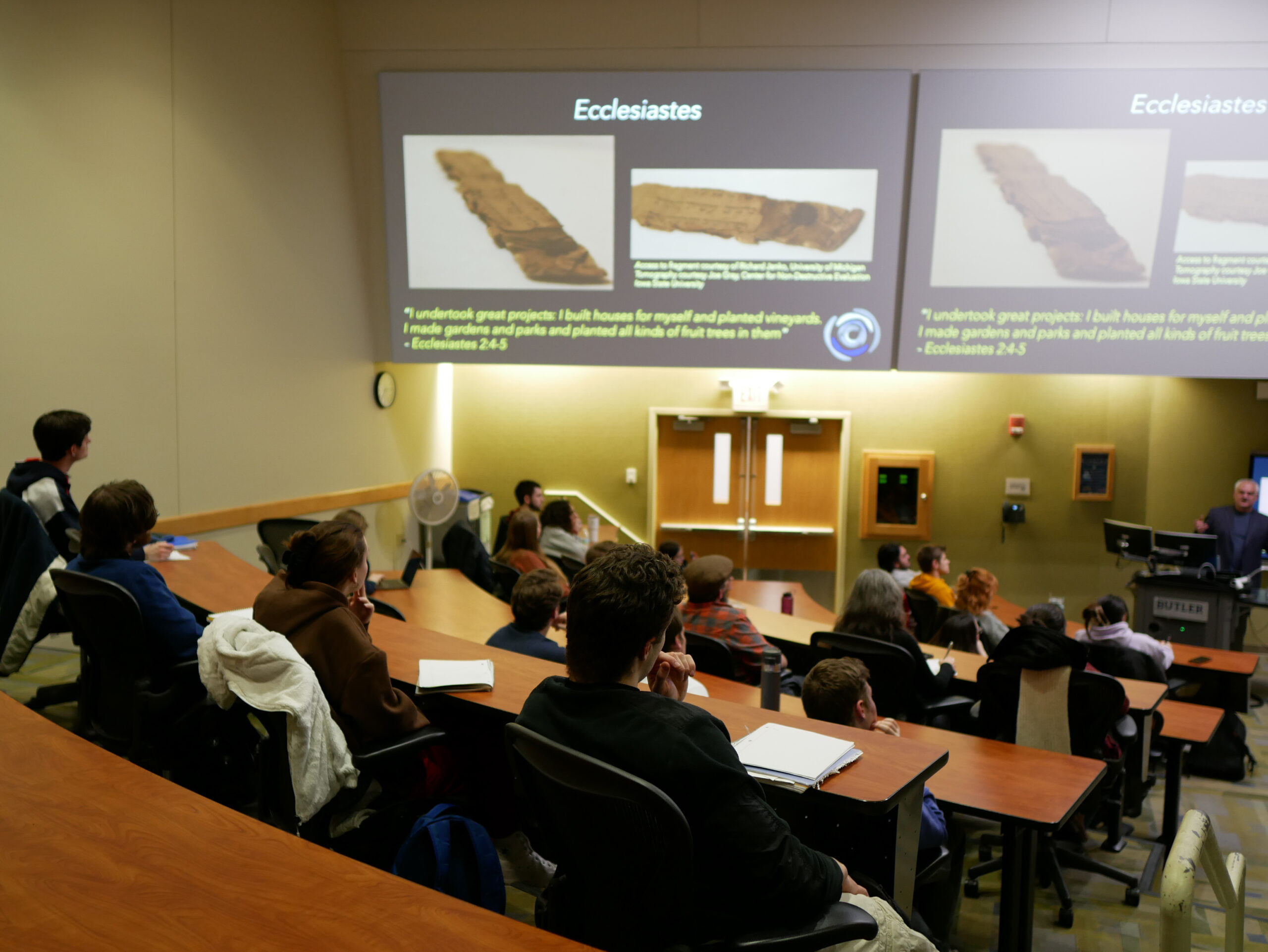Dr. Brent Seales presenting a recovered script from a cannibalized Bible. Photo by Jonathan Wang.
MAXWELL COLLINS | STAFF REPORTER | mcollins1@butler.edu
Internationally recognized computer scientist Dr. Brent Seales inspired Butler students and faculty to dive deeper into the world of digital restoration at his Feb. 29 lecture, “Using Machine Learning to Digitally Restore Ancient Scrolls”. Seales is a professor of computer science at the University of Kentucky and principal investigator of EduceLab, the University of Kentucky’s digital restoration initiative. Seales’ work catches the attention of many in both classics and computer science fields, as he has developed and trained technology that can take ancient scrolls from thousands of years ago and apply a unique set of techniques that renders the text readable.
“Experts have called the breakthrough a ‘revolution’ in Greek philosophy,” the BBC said in its 2024 coverage of Seales’ work.
The process of creating a program that can do this groundbreaking work took 10 years of human work before the technology was fully functional and accurate. While Seales and his team worked on recovering a scroll from the ruins of Herculaneum, an ancient Italian city devastated by a volcanic eruption, they found that their AI programs were not yet advanced enough to decipher the text. The team took a pause on the Herculaneum scroll project and moved to a much smaller piece of charred script, the Ein Gedi Scroll, recovered from the site of a synagogue wrecked by fire near the western shore of the Dead Sea.
The progress EduceLab made with the Ein Gedi Scroll required the repetition of a few key steps — the first of which is called segmentation where each piece of paper is digitally separated from neighboring pages of the scroll. The second, called texturing, is where the scroll is scanned by the program, which looks for differences in texture on the page, denoting the presence of ink. Finally, there is another pass that finds bright pixels, which indicate text. To work most reliably, each of these steps must be completed on one small section of scroll at a time.
Seales and the EduceLab team reached an exciting moment in 2016 when their work revealed that the first readable portion of the Ein Gedi Scroll comes from the Biblical book of Leviticus.
“It’s the first chapter of Leviticus; the first verse is, ‘God called to Moses,’” Seales said. “It’s a very inspiring text to have discovered, and it also fills a point in this timeline where the Dead Sea Scrolls [in] the Second Temple period leaves off.”
Now certain that their technology can work, EduceLab went back to working on the Herculaneum scroll. Currently, multiple parts of the scroll have been deciphered. Part of the deciphering process included getting more people involved in order to tackle this large goal. EduceLab started the “Vesuvius Challenge,” a project that awards other scholars and students with prize money for new words deciphered and translated. So far, the Vesuvius Challenge has already awarded $1,159,000 to 2023 winners and has more awards posted for 2024.
Seales has had the opportunity to give talks all over the world, as a guest lecturer for the Friends of Herculaneum Societies and as a visiting scientist at Google France. With a lengthy resume, Seales is passionate about getting more students involved in restoration work, and highlighting how the use of new technology can support it.
Senior computer science major Celine Harb attended the Feb. 29 lecture and found that some lessons could be applied across academic fields. For example, the lengthy process used by EduceLab to confirm that the AI program used had achieved the correct translation reminded Harb of how students can evaluate situations to take the right next step.
“Trust but verify,” Harb said. “We have to make a lot of life decisions at our age: what we believe and what we do, and sometimes we don’t care enough to look into things, and [sometimes] we just either decide to trust this side or this side. Things that people are unsure about, they shouldn’t just put them to the side.”
Dr. Lynne Kvapil is an associate professor of classics at Butler and the co-director of the Ancient Mediterranean Archaeology and Classics Lab. Kvapil highlighted the importance of multi-field work like Seales’s.
“The beauty of a project like this is that we start with this incredible technology that is leading to these breakthroughs that are [not only] breakthroughs for the sciences, technology and engineering, [but also] breakthroughs for the humanities in terms of understanding the past and understanding these ancient library texts,” Kvapil said.
While there is an assortment of lessons to take away from Seales’ talk, some focusing more on field-specific benefits, Seales offers a lesson any student could take from his work.
“You see the confluence here of very modern and new technology with the ancient world,” Seales said. “I think what you can take away is that your generation is not interested in letting go of those important things. This is an opportunity to grab onto them and do more than the previous generations were able to do because they didn’t have those tools. We want to transfer that excitement to you.”



